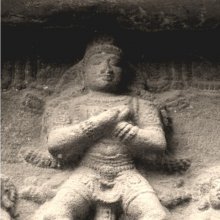Mandalasvastika, Maṇḍalasvastika, Mandala-svastika, Mamdalasvastika: 3 definitions
Introduction:
Mandalasvastika means something in Hinduism, Sanskrit. If you want to know the exact meaning, history, etymology or English translation of this term then check out the descriptions on this page. Add your comment or reference to a book if you want to contribute to this summary article.
Images (photo gallery)
In Hinduism
Natyashastra (theatrics and dramaturgy)
Source: Wisdom Library: Nāṭya-śāstraMaṇḍalasvastika (मण्डलस्वस्तिक).—One of the 108 karaṇas (minor dance movement) mentioned in the Nāṭyaśāstra chapter 4. The instructions for this maṇḍalasvastika-karaṇa is as follows, “two hands moved to unite in the Svastika gesture with their palms turned upwards in a similar manner, and the body in the Maṇḍala Sthāna (posture).”.
A karaṇa represents a minor dance movements and combines sthāna (standing position), cārī (foot and leg movement) and nṛttahasta (hands in dancing position).
Source: Shodhganga: Elements of Art and Architecture in the Trtiyakhanda of the Visnudharmottarapurana (natya)Maṇḍalasvastika (मण्डलस्वस्तिक) refers to one of the 108 kinds of Karaṇa (“coordination of precise movements of legs and hands”), according to the Viṣṇudharmottarapurāṇa, an ancient Sanskrit text which (being encyclopedic in nature) deals with a variety of cultural topics such as arts, architecture, music, grammar and astronomy.—According to the Viṣṇudharmottarapurāṇa, karaṇas are the coordination of precise movements of legs and hands performed in a particular posture. The Nāṭyaśāstra also gives its view point in the same spirit. In the Viṣṇudharmottarapurāṇa, one hundred and eight kinds of karaṇas are accepted, e.g., Maṇḍalasvastika.

Natyashastra (नाट्यशास्त्र, nāṭyaśāstra) refers to both the ancient Indian tradition (shastra) of performing arts, (natya—theatrics, drama, dance, music), as well as the name of a Sanskrit work dealing with these subjects. It also teaches the rules for composing Dramatic plays (nataka), construction and performance of Theater, and Poetic works (kavya).
Languages of India and abroad
Kannada-English dictionary
Source: Alar: Kannada-English corpusMaṃḍalasvastika (ಮಂಡಲಸ್ವಸ್ತಿಕ):—[noun] (dance.) a kind of movement of the arms, which are finally locked in swastika form.
Kannada is a Dravidian language (as opposed to the Indo-European language family) mainly spoken in the southwestern region of India.
See also (Relevant definitions)
Partial matches: Mandal, Mandala, Svastika.
Full-text: Bahu, Vaishakharecita.
Relevant text
Search found 2 books and stories containing Mandalasvastika, Maṇḍalasvastika, Mandala-svastika, Mamdalasvastika, Maṇḍala-svastika, Maṃḍalasvastika, Mandalsvastika, Maṇḍalsvastika, Mandal-svastika, Maṇḍal-svastika; (plurals include: Mandalasvastikas, Maṇḍalasvastikas, svastikas, Mamdalasvastikas, Maṃḍalasvastikas, Mandalsvastikas, Maṇḍalsvastikas). You can also click to the full overview containing English textual excerpts. Below are direct links for the most relevant articles:
Vishnudharmottara Purana (Art and Architecture) (by Bhagyashree Sarma)
2.5. Karaṇa (movements of legs and hands) < [Chapter 3 - Drama and Dance]
Natyashastra (English) (by Bharata-muni)
